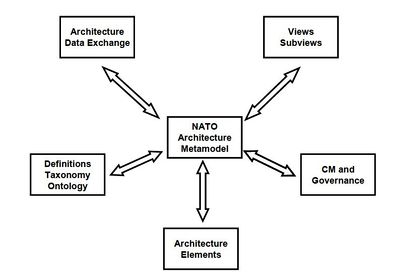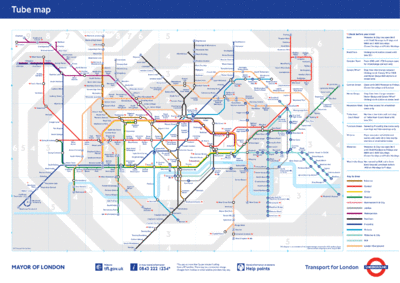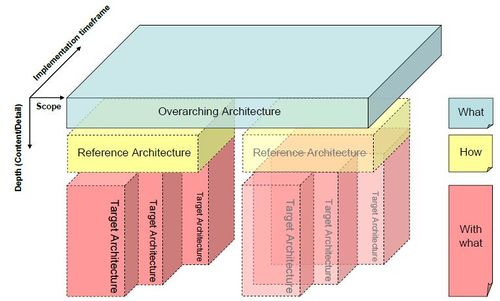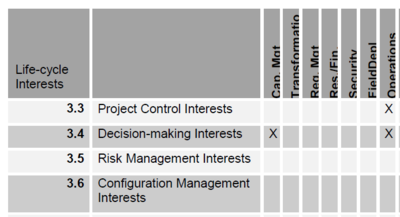Nato Architecture Framework (NAF) - 1 - Introduction
Jump to navigation
Jump to search
<slideshow style="nobleprog" headingmark="。" incmark="…" scaled="false" font="Trebuchet MS" >
- title
- NAF - Part 1 - Introduction
- author
- Bernard Szlachta (NobleProg Ltd)
</slideshow>
Current Approach。
- OMG UPDM
- DoDAF, MoDAF, NAF, SoaML in one profile
Other overviews。
Background。
- The NATO Architecture Framework is an Enterprise Architecture framework by the NATO
- Derived from the DoDAF Enterprise architecture and MoDAF
- Service Oriented (as oppose to System Oriented)
- Uses Views approach (Model Categories, or, in other words: what the stakeholder wants to see)
Version 3.1 of the NATO Mata Model is identical to v1.2.003 of the MODAF Meta-Model
Versions。
- Current version 3.1, though only MetaModel (the rest stays as in 3.0)
- Future versions 4 is currently a draft: http://nafdocs.org/introduction/
- Version 4 may include methodology in addition to the framework
- "The final version of the NAF Chapter 5 v3.1 was issued, and the 9th C3 PWG meeting agreed to defer the associated revisions of NAF v3 chapters 3,4 and 7." http://www.nhqc3s.nato.int/HomePage.asp
NAF and other standards 。
- MoDAF/DoDAF
- UPDM (OMG)
- TRAK
- SOAML
- SYSML
- Interesting mapping to other frameworks http://link.springer.com/chapter/10.1007/978-3-642-24849-8_11
NATO C3 。
- NC30 The NATO Consultation, Command and Control Organization
- Its main objective is to provide a coherent, secure and interoperable C3 capability to the NATO.
- Fromed in 1996
- The NATO Consultation, Command and Control Board (NATO C3 Board or NC3B)
- Acts as a Board of Directors for the NC3O and as its main policy body.
- In July 2012, NC3A merged into the NATO Communications and Information Agency (NCIA).
NATO C3 Organisation Mission。
- Ensure the provision of a
- NATO-wide cost-effective,
- interoperable and secure C3 capability
- that meets the users’ requirements
- by making use of common funded, multinational cooperative and national assets in the most effective and efficient manner;
- Ensure the provision of services and support in the field of C3 to NATO users...
- Act as the NATO overarching authority in the area of C3 architectures to enable the effective integration of C3 capabilities into a NATO-wide network thereby supporting the NATO Network-Enabled Capability (NNEC) concept ...
NAF goals。
- Provide guidance for developing and describing NATO architectures
- NAF v. 3 enables a paradigm shift from human communication through mass amounts of written text to communication by standardized models of the real world.
- Information Accessibility (NAR)
- Improve trust and reduce cultural limits - Incorporation of tools, a common language expressed by the NAF that allow for better inter-cultural understanding, interoperability and trust building.
Framework Documentation Structure。
- Though in theory is freely published it cannot be freely downloaded any longer
- ANNEX1.pdf (all parts combined without executive summary
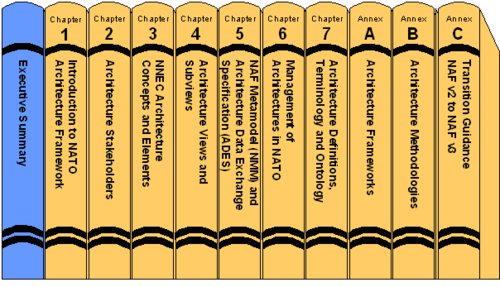
What is inside the NAF。
How NAF works。
- A view is what the stakeholder wants to see
- The instantiation of a sub-view, is a product
- A specific set of instantiated sub-views would make an architecture description.
NATO Network Enabled Capability。
- NNEC will be a federation of systems as opposed to a system of systems.
- Therefore SOA concepts are crucial
What is an Enterprise Architecture?。
- more than a plan put together in accordance with certain rules.
- diagrams (blueprints),
- lists (bills of material)
- documents (specifications)
- Each of these parts of the architecture is different ways of looking at your house (views)
- The term architecture describes the total collection of diagrams, lists and documents
- NAF consists capability, operation, business, system or services views
- Views are diagrams, list or text
- Views define design, structure and behaviour of the operation, business or system
How to describe the architecture?。
- Architectures can be represented by models
- Models are simplified version of the reality
- We simplify the reality on purpose, i.e. more precise or complete models are usually worse, harder to use than simple, more abstract one
- Architectures should not be generated without a clear purpose in mind!
- EA provides an abstraction of the real world, and by reducing complexity the architectures can be used to provide a variety of analyses.
Why Architecture Matters?。
- EA provides decision support, in the context of the enterprise strategy, for the use of resources (including processes and procedures) in the enterprise.
- EA is responsible for defining how resources support the strategy of the enterprise and goals and objectives
- Enterprise architecture touches every part of the organisation.
- Architectures are to be used as analysis tools to develop new capabilities, structure organisations and to optimize processes and spending.
Architecture is a language。
- views and the reports generated from the NMM based repository defines a common language for architecture representation, and it provides the means to help achieve better communication between architects as well as between architects and stakeholders.
- The use of standardized views serves as a lingua franca as it provides a unified way of describing complex real world objects.
EA and decisions。
- Enterprise and Portfolio Management
- Operational Planning
- Acquisition Programme Management and System Development
- Modelling and Simulation
Types of NATO Architectures。
- What is the required functionality? (OA)
- Logically, How can this functionality be met? (RA)
- Practically, what can be used, or With what can solutions be implemented? (TA)
- as is, the Baseline Architecture (BA)
Quiz: Which architecture is described by the sentences below?。
- A more focused description of the construction with full detail to guide programme execution.
- A description limited to the scope of a single project addressing implementation decisions. Such a description builds on the previous type of architecture and illustrates the implementation (With what-question) of the previously described construction.
- An enterprise-wide description of the future situation with limited detail, i.e. the What-question.
Overarching Architecture (OA)。
- top-down description of the desired configuration of the NATO C3 System
- necessary to meet NATO’s medium to long-term (up to 15 years) capability requirements
- describes the relationships between the systems necessary to perform the functions of NATO C3 regardless of the scope (source of funding)
- rendered at a high level, but is detailed enough to identify, using standardized products, systems and system components within the User, Network, and Sensor domains, how they are interlinked, and how they interface with external C3 systems
- basis for recommendations for the development of future C3 systems policies and strategic plans
Reference Architectures (RA)。
- there are many of them
- support the development of Capability Packages under the NATO Security Investment Programme (NSIP)
- reflect NATO strategic decisions regarding system technologies, stakeholder issues, and product lines.
- render user requirements, processes, and concepts in a high-level solution from which individual projects can be identified and initially programmed
- their primary focus is on services, processes and component functionality, and they provide the basis for the development of Target Architectures (TA)
- RAs cover the entire planning cycle for a typical NATO system development, which is normally six years.
Target Architectures (TA)。
- support the preparation of NSIP Type B Cost Estimates (TBCE)
- derived from the related RA
- specify a system design at a detail sufficient to direct the acquisition and integration of components to achieve a desired capability
- TAs focus on specifications for systems and services
- transitional of nature and are usually valid for the duration of the system acquisition and initial design
- TAs modify the baseline architecture and can provide feedback to an RA
Baseline Architecture。
- description of the fielded ‘as is’ state of the NATO C3 enterprise
- Baselines (portions of the NATO architecture baseline) are used in NATO’s Mission Oriented Analysis (MOA) process to help assess potential solutions to evolving operational requirements
- Baselines are tools necessary for the user, planner, manager, and system custodian to comprehensively establish, understand, and maintain the current enterprise or domain configuration
- Baselines are rendered for NATO and National systems at a level of detail necessary for depiction of system components, their interconnectivity with each other, and any relevant external connectivity
NATO Architecture Views。
- There are 7 views (AKA perspectives)
1. NATO All View (NAV)
2. NATO Capability View (NCV)
3. NATO Programme View (NPV)
4. NATO Operational View (NOV)
5. NATO Systems View (NSV)
6. NATO Service-Oriented View (NSOV)
7. NATO Technical View (NTV)
NATO Architecture Views。
- 1. NATO All View (NAV)
- Captures overarching aspects that relate to all seven views
- Do not represent a distinct view of the architecture
- Set the scope and context of the architecture
- The scope includes the subject area and timeframe for the architecture
- The setting in which the architecture exists comprises the interrelated conditions that compose the context for the architecture.
- These conditions include:
- doctrine;
- tactics,
- techniques,
- procedures;
- relevant goals and vision statements;
- concepts of operations;
- scenarios;
- environmental conditions.
NATO Architecture Views。
- 2. NATO Capability View (NCV)
- supports the process of analyzing and optimizing the delivery of military capabilities in line with NATO’s strategic intent
- captures essential elements of NATO’s strategic vision and concepts and NATO’s capability planning process, and decomposing this data into a capability taxonomy
- The taxonomy is augmented with schedule data and measures of effectiveness to enable the analysis of capability gaps and overlaps
- further details the dependencies between military capabilities, enabling capability options to be built in a more coherent manner and effective trade-offs to be conducted across NATO common funded programmes
- 3. NATO Operational View (NOV)
- description of the tasks and activities, operational elements, and information exchanges required to accomplish NATO missions
- NATO missions include both war-fighting missions and business processes
- NOV contains graphical and textual products that comprise an identification of the operational nodes and elements, assigned tasks and activities, and information flows required between nodes
- It defines the types of information exchanged, the frequency of exchange, which tasks and activities are supported by the information exchanges, and the nature of information exchanges
NATO Architecture Views。
- 4. NATO Service-Oriented View (NSOV)
- description of services needed to directly support the operational domain as described in the NATO Operational View
- A service, within the NSOV, is understood in its broadest sense, as a unit of work through which a provider provides a useful result to a consumer
- NSOV focuses strictly on identifying and describing services
- The view also:
- supports the description of service taxonomies
- service orchestrations
- mapping of services to operational activities
- description of service behaviour
NATO Architecture Views。
- 5. NATO Systems View (NSV)
- set of graphical and textual products that describes systems and system interconnections providing for, or supporting, NATO functions
- NATO functions include both war-fighting and business functions
- The NSV associates systems resources to the NOV
- These systems resources support the operational activities and facilitate the exchange of information among operational nodes
- Note that systems providing services can be pure technical systems as documented in the systems view only or a combination of technical and operational elements that is documented with a combination of an operational node and one or several associated system nodes
- A logical system providing services is documented in the service-oriented view only
NATO Architecture Views。
- 6. NATO Technical View (NTV)
- the minimal set of rules governing the arrangement, interaction, and interdependence of system parts or elements
- Its purpose is to ensure that a system satisfies a specified set of operational requirements
- The NTV provides the technical systems implementation guidelines upon which engineering specifications are based, common building blocks are established, and product lines are developed
- The NTV includes a collection of the technical standards, implementation conventions, standards options, rules, and criteria organised into profile(s) that govern systems and system elements for a given architecture
- 7. NATO Programme View (NPV)
- describe the relationships between NATO capability requirements and the various programmes and projects being implemented
- They provide programmatic details and highlight the dependencies between capability management and the NATO acquisition process
- This information can be further leveraged to show the impact of acquisition decisions on the architecture
Stakeholders。
- Architectural activities within NATO shall support all life-cycle development processes of NATO’s capabilities.
- The development processes should be formally described and related to the architecture interests of the NATO bodies that have stakeholder interests in new capability-enhancing systems.
- NAF supports the management structure for stakeholders to exercise control
- NAF is an instrument through which stakeholders can exercise their influence and control, at any level and at any stage, during life-cycle development process of any such capability.
Communities of Interest。
- NATO’s force goals require that systems facilitate interoperability
- number of NATO stakeholders having an interest in and wanting to influence the development of new interoperable systems is large and diverse
- single stakeholder may have multiple but diverse interests concerning the capability development process
- field of stakeholders represents a great variety of interests in that process
- NAF challenge is to link stakeholders varied interests within a complex capability development process
- This link is provided by Communities of Interest (CoI) in which all stakeholders that share common goals, interests, missions or operational processes collaborate in order to put their concerns into effect during the overall life-cycle development process
- Through so-called interest related ‘Views’, (see Chapter 4), the CoIs will be properly and adequately informed about the status and all other aspects and details that are relevant to their interest in the progress of the development process.
Life-cycle management in NAF。
- The ISO Life-cycle Process Management Standard 15288 covers most of the CoIs architecture interests and concerns
- NATO will embrace the ISO Life-cycle Process Management Standard in their future business
- NATO applies quality assurance procedures as identified in Allied Quality Assurance Publications (AQAP) in accordance with STANAG 4107 Edition 8
How NAF align stakeholders interest with the architecture?。
- All stakeholders having an interest in, or an impact on, NATO’s future architectures are identified;
- A set of various Communities of Interest (CoIs) that are relevant in regard to NATO’s future architectures is identified;
- The stakeholders’ involvement in the CoIs is made explicit;
- The CoIs interests in, and impacts on, NATO’s future architectures are made explicit.
Identification of Stakeholders。
| Organisation | Typical architecture related interests |
|---|---|
| CNAD (Conference of National Armaments Directors) |
|
| IC (Infrastructure Committee) |
|
Identification of Communities of Interest (CoIs)。
- Each stakeholder may have a range of diverse interests, and significant overlaps between stakeholders’ interests may exist
- Therefore, stakeholders collaborate in so-called Communities of Interest (CoIs) in which consistent sets of specific architecture interests and involvements will be addressed
- In NNEC terminology, a CoI is a collaborative grouping of users who share and exchange information in the pursuit of common goals or missions.
- Within a CoI the participants work together to resolve the issues that affect their community;
- CoIs are virtual groups and inherently cross-organisational
- They facilitate the efficiency and effectiveness in communicating the architectures and delivery of products to the stakeholders.
Example CoIs。
| Abbreviation | CoI | Architecture interest description |
|---|---|---|
| HR | Human Resource |
|
| Req. Mgt | Requirements Management |
|
For more information see Chapter 2 Page 7 of NAF
Relation between Stakeholders and CoI’s。
| Cap. Mgt | Transformation | Req. Mgt |
|---|---|---|
| ACT | X | X |
| ACO |
Requirements Analysis of CoIs。
- There are concerns of the CoIs on the various aspects of life-cycle capability development process
- The concerns are better understood through a more detailed description of their sub-interests and impacts (on CoIs)
Description of CoI Interests。
- Agreement Interests
- Acquisition Interests
- Suppliers Interests
- Enterprise Interests
- Enterprise Environment Management Interests
- Investment Management Interests
- System Life-cycle Processes Management Interests
- Resource Management Interests
- Quality Management Interests
- Security Management Interests
- Project Interests
- Project Planning Interests
- Project Assessment Interests
- Project Control Interests
- Decision-making Interests
- Risk Management Interests
- Configuration Management Interests
- Information Management Interests
- Engineering Interests
- Stakeholder Requirements Definition Interests
- Requirements Analysis Interests
- Architectural Design Interests
- Implementation Interests
- Integration Interests
- Verification Interests
- Transition Interests
- Validation Interests
- Operation Interests
- Maintenance Interests
- Disposal Interests
CoI’s Architecture Interests and Impacts。
Requirements of Architecture Views。
- If the entire life-cycle is taken into capability development scope then at least the following interests must be covered and addressed:
- Agreement Interests
- Enterprise Interests
- Project Interests
- Engineering Interests
- Views scope must be widened (from technical) to also include the other processes mentioned above
- Consequently, views must be developed that feed back appropriate information to the CoIs in all areas of interest as have been mentioned above.
